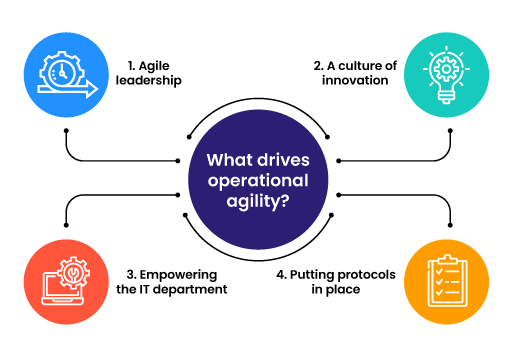
This article was first published on Customer Think.
If there was one lesson for organizations after 2023, it was learning to adapt to market turbulences and to stay afloat even in the most unexpected circumstances. As the pandemic disrupted organizations in every possible way, the ones to deal with it the best were the ones who had their infrastructure and organizational culture competent enough to deal with the unexpected. In the digital age, businesses are transforming more than what their digital infrastructure can handle, and disruptions have become the way of life. In such a scenario, operational agility becomes a significant must-have, instead of just a good-to-have.
So, what exactly is operational agility?
Operational agility is an organization’s ability to modify and adapt its operations and technology to a perpetually evolving business environment. These evolving changes are brought on by a bunch of factors, right from competitive moves to a shift in market dynamics. Agile organizations win on resilience and ensure their growth and survival irrespective of the way the market shapes itself. As such organizations are always on their toes, ready to embrace the next challenge thrown at them, they manage to continue business processes and stakeholder expectations continuously.
Operational agility also allows organizations to have an edge over their competitors, as they can prance on opportunities and deal with challenges quicker than their competition. In fact, a survey by McKinsey found that nine out of ten executives ranked organizational agility both as critical to business success and as growing in importance over time. According to this survey, the benefits of operational agility ranged from higher revenues to increased customer satisfaction.
Now that we have established just how important operational agility is for any organization that wants to survive and thrive, it begs the question:

What drives operational agility?
Here are a few pointers that need to be ensured if you’re planning to make your organization agile:

1. Agile leadership
It is a well-known fact that organizations are defined by the way their leadership functions. Leaders pave the way for innovation and flexibility, by setting the tone with their decisions and policies. Therefore, to achieve operational agility, utmost importance should be given to ensuring that the leaders are aligned to operational agility. It is the responsibility of future-ready leaders to take a long and hard look at the various processes of their organization and to identify opportunities for innovation and agility. Leaders don’t only lead through their decisions and strategies, but also through inspiration and encouragement. Change becomes at the top, and achieving operational agility is no different.
2. A culture of innovation
Continuing the point raised above, after the leadership the onus comes on team members to approach things in a manner that is flexible and innovative. Once the leaders have communicated their vision and plan to the employees, they need to break it down into actionable units that can be implemented on a day-to-day basis.
There are various approaches to promoting innovation, a proven one being giving importance to citizen development. Citizen development allows business users to build their own solutions, with little to no dependence on the IT departments. As the solutions are built by the people who understand the problem the most, there is immense scope for flexibility and innovation. It also assures employees that they don’t need intense technical skills to make an impact, as they can use no-code platforms like Quixy to get the desired results in a fraction of time and resources.
Another significant benefit of an innovative culture is problem-solving. As business users are equipped to build their own solutions, they approach bottlenecks and obstacles with a never-say-die attitude that is extremely beneficial to operational agility.
3. Empowering the IT department
Owing to the steep growth in the demand for digital solutions and infrastructure, IT departments are often extremely burdened and overworked. They have the onus to build multiple solutions while adhering to specific requirements and deadlines, making it very hard for them to work efficiently. This is where tools like no-code can help immensely. As business users are empowered to build their own solutions through the power of citizen development, the workload on IT departments decreases.
This allows them to focus on the more complex requirements and strategic tasks, hence producing better results within deadlines. This also gives them the room to align the department with operational agility as they get increased flexibility. Instead of using their resources on day-to-day challenges, the IT departments get to make a more significant impact.
4. Putting protocols in place
Behind the strategies that are put in place to ensure agility, there needs to be a structure and a clear set of responsibilities that define the scope of work of various levels of employees. Some roles might be cross-functional as well, so an emphasis on the exact expectations need to be defined. This will help in distributing the onus of bringing about operational agility and will also act as a benchmark for performance management.
Also read: 5 ways to achieve Success with No-code Low-Code
Takeaway
Needless to say, the only way to succeed in a turbulent business environment is to achieve full operational agility. In addition to the points mentioned above, bringing in the right technology to enable agility is extremely important. No-code tools work wonders in this regard, as they are a leap ahead of traditional development. Not only do they cut the time and costs associated with old-school development, but they also lead to the creation of highly functional digital solutions. By continuously improving on these solutions, business users are enabled to bring in a significant impact towards the cause of operational agility.
Quixy is a leading no-code platform that has helped organizations across sizes and industries to bring about operational agility by transforming their processes. Our user-friendly platform can be used to build digital solutions in no time, right from the simple to the complex ones. If you are striving to inculcate operational agility in your organizations, Quixy is a platform you just can’t miss.
Get started with our platform, and experience the ease of automated processes and personalized app building.
Subscribe
Login
Please login to comment
0 Comments
Oldest
















